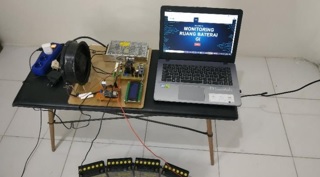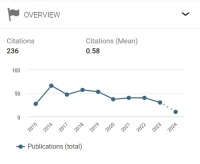Prototipe Alat Monitoring Suhu dan Kelembapan Ruang Baterai pada Gardu Induk Berbasis IoT
Abstract
The battery room is always maintained at a certain temperature and humidity level to prevent the batteries from degrading due to high temperatures and poor air circulation. The aim of this study is to develop a system for monitoring and controlling the temperature and humidity in the battery room, ensuring the reliability of the power supply. The method used includes designing the mechanical and electrical prototype system and developing the controller program, followed by testing the entire system. The system consists of an STM32F103C8T6 microcontroller using a DHT-22 sensor to measure the temperature and humidity in the battery room, a voltage sensor to measure the battery voltage, and an exhaust fan. The test results showed a temperature measurement error of 0.2%, a humidity error of 4.04%, and an average battery voltage error of 0.5%. The exhaust fan operates with a duty cycle control that generates input voltages of 29.8 V, 34.88 V, and 42.88 V, which align with the standard temperature and humidity values in the battery room.
Downloads
References
[2] K. Handayani, T. Filatova, and Y. Krozer, “The Vulnerability of the Power Sector to Climate Variability and Change: Evidence from Indonesia,” Energies, vol. 12, no. 19, p. 3640, Sep. 2019, doi: 10.3390/en12193640.
[3] R. Kurniawan, S. Supratno, and S. Samsiana, “Analisis Penyebab Kegagalan Inverter DC-AC Sistem Back Up Daya di Gardu Induk Cibatu dengan Metode RCA,” Aviat. Electron. Inf. Technol. Telecommun. Electr. Control., vol. 6, no. 2, p. 193, Aug. 2024, doi: 10.28989/avitec.v6i2.2467.
[4] H. Birje, S. Hasan, and M. Pinem, “Dc Battery Optimization in 275 Kv Main Gardu to Improve The Reliability of the Control System,” J. Phys. Conf. Ser., vol. 1933, no. 1, p. 012105, Jun. 2021, doi: 10.1088/1742-6596/1933/1/012105.
[5] S. Huang, R. Wang, and Z. Yang, “Substation DC system intelligent monitor and maintenance system,” in 2017 IEEE 2nd Advanced Information Technology, Electronic and Automation Control Conference (IAEAC), Mar. 2017, pp. 2068–2072. doi: 10.1109/IAEAC.2017.8054381.
[6] I. N. Nurhadi and L. Liliana, “Pengaruh Temperatur dan Nilai Berat Jenis Cairan Elektrolit Terhadap Tegangan Sel Baterai Nickel Cadmium 110 Vdc Gardu Induk Perawang Sistem 150 kV,” CYCLOTRON, vol. 5, no. 2, 2022.
[7] M. F. Istiqlal, E. Priatna, and S. Sutisna, “ANALISA KAPASITAS BATERAI SEBAGAI SUMBER DC PADA GARDU INDUK TEGANGAN EKSTRA TINGGI 500 KV PT. PLN (PERSERO) TASIKMALAYA,” J. Energy Electr. Eng., vol. 4, no. 2, 2023.
[8] Sugianto and N. Lubis, “Kegagalan Proteksi pada Gardu Induk 150 kV Akibat Suplai Tegangan DC,” Sinusoida, vol. 19, no. 2, pp. 18–27, 2017, [Online]. Available: https://ojs.istn.ac.id/index.php/sinusoida/article/viewFile/7/8
[9] C. H. B. Apribowo, S. Sarjiya, S. P. Hadi, and F. D. Wijaya, “Optimal Planning of Battery Energy Storage Systems by Considering Battery Degradation due to Ambient Temperature: A Review, Challenges, and New Perspective,” Batteries, vol. 8, no. 12, p. 290, Dec. 2022, doi: 10.3390/batteries8120290.
[10] A. Rahmadani, N. A. Windarko, and L. P. S. Raharja, “Rancang Bangun Sistem Monitoring Suhu dan Kelembapan serta Kendali Dua Heater pada Kubikel 20 kV Berbasis Sistem Informasi Geografis,” Maj. Ilm. Teknol. Elektro, vol. 21, no. 2, p. 219, Dec. 2022, doi: 10.24843/MITE.2022.v21i02.P09.
[11] M. B. P. Ramadhan, M. Z. Efendi, and S. D. Nugraha, “Temperature and Humidity Control System for 20 kV of Cubicle with Multiple Input Multiple Output Fuzzy Logic Controller,” JAREE (Journal Adv. Res. Electr. Eng., vol. 7, no. 2, Jul. 2023, doi: 10.12962/jaree.v7i2.367.
[12] F. N. Oktaviani and A. Rahmadani, “Implementation of Elman Neural Network with Backpropagation Algorithm for Battery State of Charge Estimation,” in 2024 International Conference on Technology and Policy in Energy and Electric Power (ICTPEP), Sep. 2024, pp. 118–123. doi: 10.1109/ICT-PEP63827.2024.10733470.
[13] PT. PLN (Persero), “Buku pedoman pemeliharaan sistem supli AC/DC,” Jakarta PT. PLN Persero, 2014.
[14] N. Nadhiroh, R. Fierdaus, and Isdawimah, “IoT based Battery Storage Temperature Monitoring System,” in 2022 5th International Conference of Computer and Informatics Engineering (IC2IE), Sep. 2022, pp. 258–261. doi: 10.1109/IC2IE56416.2022.9970080.
[15] S. Mahlangu, M. Sibanyoni, L. Ngoma, and S. P. D. Chowdhury, “The design of HVAC network control panel for battery room,” in 2020 6th IEEE International Energy Conference (ENERGYCon), 2020, pp. 787–791.
[16] I. P. W. P. K. Jaya and I. G. A. Widagda, “Pembuatan Alat Pantau Suhu Dan Kelembaban Udara Berbasis Short Message Service (SMS) Menggunakan AWE. 2020,” Bul. Fis. Vol, vol. 22, no. 1, pp. 12–19, 2021.
[17] M. S. D. Utomo et al., “Analisis perhitungan teori dengan menggunakan variasi simulator online pada rangkaian pembagi tegangan,” Telecommun. Networks, Electron. Comput. Technol., vol. 1, no. 2, pp. 61–70, 2021.
[18] A. Rahmadani and A. A. Prastiyo, “Sistem Pendeteksi Arc Flash Pada Sambungan Jaringan Tegangan Rendah Dengan Sensor LDR Berbasis Telegram,” J. Teknol. Elektro, vol. 14, no. 1, p. 18, Feb. 2023, doi: 10.22441/jte.2023.v14i1.004.
[19] I. K. C. Arta, A. Febriyanto, I. B. M. H. A. Nugraha, I. G. S. Widharma, and I. B. I. Purnama, “Animal Tracking Berbasis Internet of Things,” Maj. Ilm. Teknol. Elektro, vol. 21, no. 1, p. 7, Jul. 2022, doi: 10.24843/MITE.2022.v21i01.P02.
[20] T. Sutikno, J. Alfahri, and H. S. Purnama, “Monitoring Tegangan dan Arus Pada Panel Surya Menggunakan IoT,” Maj. Ilm. Teknol. Elektro, vol. 22, no. 1, p. 153, 2023.
[21] S. Badri and K. Krismadinata, “Design of Boost Converter Integrated with Graphical User Interface,” Motiv. J. Mech. Electr. Ind. Eng., vol. 2, no. 1, pp. 31–42, Jan. 2020, doi: 10.46574/motivection.v2i1.40.


This work is licensed under a Creative Commons Attribution-NonCommercial-NoDerivatives 4.0 International License.

This work is licensed under a Creative Commons Attribution 4.0 International License




